情态动词考点归纳
- 格式:ppt
- 大小:536.50 KB
- 文档页数:2
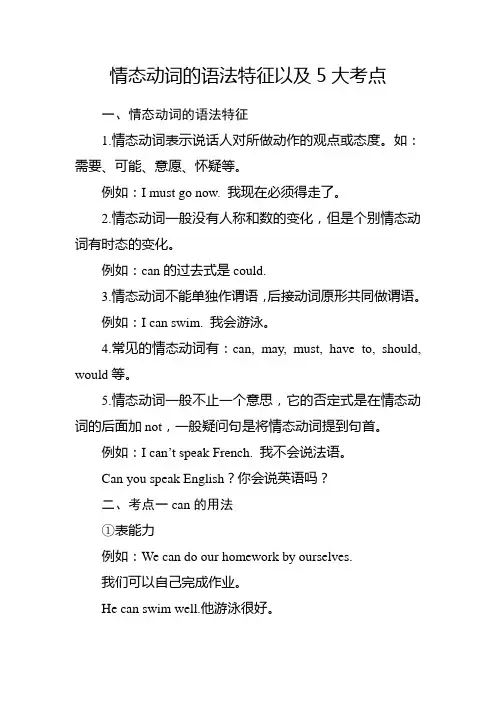
情态动词的语法特征以及5大考点一、情态动词的语法特征1.情态动词表示说话人对所做动作的观点或态度。
如:需要、可能、意愿、怀疑等。
例如:I must go now. 我现在必须得走了。
2.情态动词一般没有人称和数的变化,但是个别情态动词有时态的变化。
例如:can的过去式是could.3.情态动词不能单独作谓语,后接动词原形共同做谓语。
例如:I can swim. 我会游泳。
4.常见的情态动词有:can, may, must, have to, should, would等。
5.情态动词一般不止一个意思,它的否定式是在情态动词的后面加not,一般疑问句是将情态动词提到句首。
例如:I can’t speak French. 我不会说法语。
Can you speak English?你会说英语吗?二、考点一can的用法①表能力例如:We can do our homework by ourselves.我们可以自己完成作业。
He can swim well.他游泳很好。
I can play football but I can’t play the piano.我会踢足球但是我不会弹钢琴。
②表许可例如:You can watch TV after supper.晚饭后你可以看电视。
例如:You can’t play basketball in the street.你不能在街上打篮球。
③表请求例如:Can you help me with my math?你能帮我学数学吗?Could you lend your book to me?你能把你的书借给我吗?注意:could 是can的过去式,但是这里并不表示过去时,而是表示委婉语气。
④表示“不可能……”情态动词can的否定式,可以用来表示否定的推测,意为“不可能……”。
例如:That can’t be her father, because her father has gone to England.那人不可能是她爸爸,因为她爸爸已经去英国了。
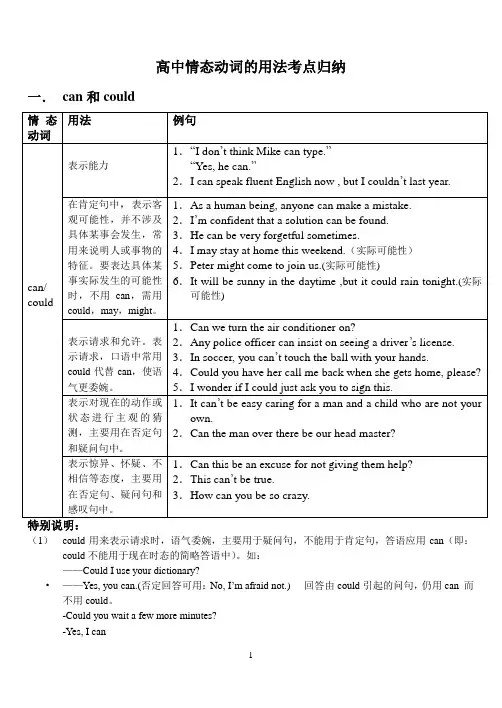
高中情态动词的用法考点归纳一.can和could(1)could用来表示请求时,语气委婉,主要用于疑问句,不能用于肯定句,答语应用can(即:could不能用于现在时态的简略答语中)。
如:——Could I use your dictionary?•——Y es, you can.(否定回答可用:No, I’m afraid not.)回答由could引起的问句,仍用can 而不用could。
-Could you wait a few more minutes?-Y es, I can(2)can和be able to辨析can(could)和be able to都可以表示能力,意思上没有区别。
但can只有现在式和过去式,而be able to则有更多的形式。
如:I’ve always wanted to able to speak fluent English.Those bags look really heavy, are you sure you’ll be able to carry them on your own?但是,表示在过去某时的某一场合经过一番努力,终于做成了某事,通常不用could,而用was/were able to来表示。
这时,was/were able to相当于managed to do或succeed in doing。
如:After the accident it was a long time before she was able to walk again.The fire was very big, but most people were able to escape from the building.(3) 惯用形式“cannot …too…”表示“无论怎么……也不(过分)”。
如:Y ou cannot be too careful.你越小心越好。
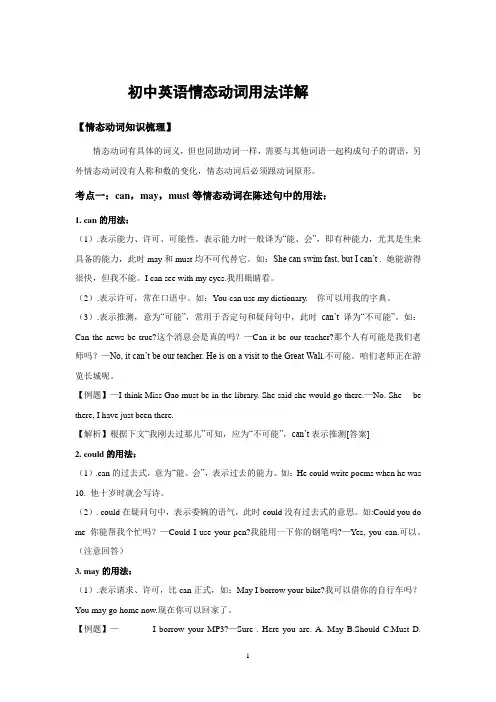
初中英语情态动词用法详解【情态动词知识梳理】情态动词有具体的词义,但也同助动词一样,需要与其他词语一起构成句子的谓语,另外情态动词没有人称和数的变化,情态动词后必须跟动词原形。
考点一:can,may,must等情态动词在陈述句中的用法:1. can的用法:(1).表示能力、许可、可能性。
表示能力时一般译为“能、会”,即有种能力,尤其是生来具备的能力,此时may和must均不可代替它。
如:She can swim fast, but I can’t . 她能游得很快,但我不能。
I can see with my eyes.我用眼睛看。
(2).表示许可,常在口语中。
如:You can use my dictionary. 你可以用我的字典。
(3).表示推测,意为“可能”,常用于否定句和疑问句中,此时can’t译为“不可能”。
如:Can the news be true?这个消息会是真的吗?—Can it be our teacher?那个人有可能是我们老师吗?—No, it can’t be our teacher. He is on a visit to the Great Wal l.不可能。
咱们老师正在游览长城呢。
【例题】—I think Miss Gao must be in the library. She said she would go there.—No. She __be there, I have just been there.【解析】根据下文“我刚去过那儿”可知,应为“不可能”,can’t表示推测[答案]2. could的用法:(1).can的过去式,意为“能、会”,表示过去的能力。
如:He could write poems when he was 10. 他十岁时就会写诗。
(2). could在疑问句中,表示委婉的语气,此时could没有过去式的意思。
如:Could you do me 你能帮我个忙吗?—Could I use your pen?我能用一下你的钢笔吗?—Yes, you can.可以。

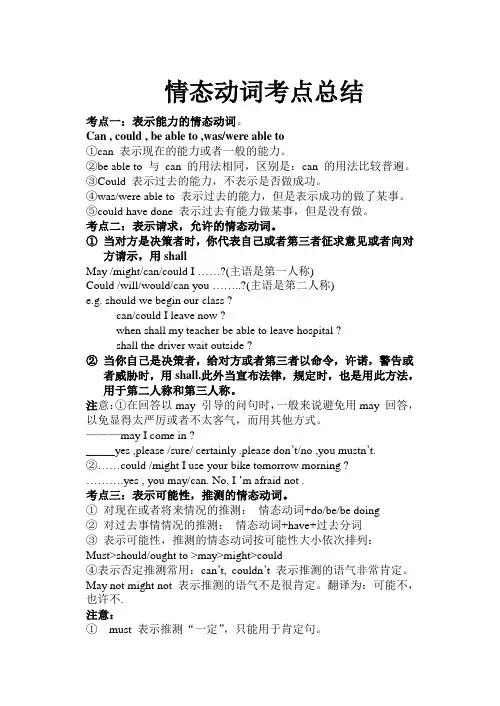
情态动词考点总结考点一:表示能力的情态动词。
Can , could , be able to ,was/were able to①can 表示现在的能力或者一般的能力。
②be able to 与can 的用法相同,区别是:can 的用法比较普遍。
③Could 表示过去的能力,不表示是否做成功。
④was/were able to 表示过去的能力,但是表示成功的做了某事。
⑤could have done 表示过去有能力做某事,但是没有做。
考点二:表示请求,允许的情态动词。
①当对方是决策者时,你代表自己或者第三者征求意见或者向对方请示,用shallMay /might/can/could I ……?(主语是第一人称)Could /will/would/can you ……..?(主语是第二人称)e.g. should we begin our class ?can/could I leave now ?when shall my teacher be able to leave hospital ?shall the driver wait outside ?②当你自己是决策者,给对方或者第三者以命令,许诺,警告或者威胁时,用 shall.此外当宣布法律,规定时,也是用此方法,用于第二人称和第三人称。
注意:①在回答以may 引导的问句时,一般来说避免用may 回答,以免显得太严厉或者不太客气,而用其他方式。
———may I come in ?_____yes ,please /sure/ certainly .please don’t/no ,you mustn’t.②……could /might I use your bike tomorrow morning ?……….yes , you may/can. No, I ‘m afraid not .考点三:表示可能性,推测的情态动词。
①对现在或者将来情况的推测:情态动词+do/be/be doing②对过去事情情况的推测:情态动词+have+过去分词③表示可能性,推测的情态动词按可能性大小依次排列:Must>should/ought to >may>might>could④表示否定推测常用:can’t, couldn’t 表示推测的语气非常肯定。

Unit9 情态动词 I语法考点超级归纳考点一:情态动词的基本用法1. 情态动词的概念情态动词又称为情态助动词(Modal Auxiliary)。
它具有词汇意义,但意义不够完整,因此一般不能单独作谓语。
情态动词表示说话人的语气和态度。
2. 情态动词的特征情态动词具有以下五个特征:(1)情态动词后面一般接原形动词(即不带to的不定式);(2)情态动词没有人称和数的变化;(3)情态动词与其他动词构成谓语时总是放在其他动词之前;(4)情态动词无非谓语形式,即没有不定式、动名词和分词形式;(5)情态动词只有现在式和过去式两种形式,但可以表示现在时间、过去时间和将来时间。
3. 情态动词的意义常见的情态动词如下表所示:现代英语语法还将have to, used to, had better, would rather, be going to, be about to等也都列为情态动词。
考点二:表示“能力”的情态动词考点三:表示“允许”的情态动词注:注意:as well 在口语中常与may或might连用,作“也好,也行”或“倒不如”解,用来缓和语气。
例如:You may as well go. 你去也好。
The weather was so bad that we might(just)as well have stayed at home. 天气太糟糕,早知道如此,倒不如呆在家里为好。
考点四:表示“推测”的情态动词gate just a moment ago.h.考点五:“情态动词+have+过去分词”表示“过去推测”“can/could/may/must+have+过去分词”表示对过去情况的推测hat注意:could, might表示推测时不表示时态,其推测的程度不如can, may。
考点六:表示“应该”的情态动词注:考点七:表示“意愿”的情态动词wil考点八:“情态动词+have+过去分词”表示“责备”“情态动词+have+过去分词”表示已经完成的动作或存在的状态,并带有感情色彩。
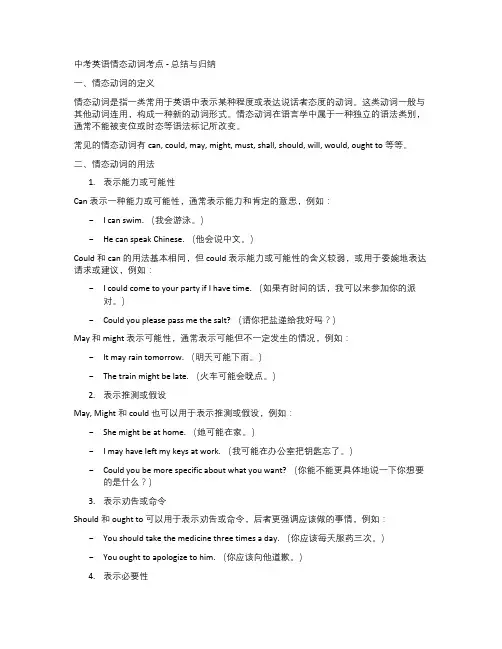
中考英语情态动词考点 - 总结与归纳一、情态动词的定义情态动词是指一类常用于英语中表示某种程度或表达说话者态度的动词。
这类动词一般与其他动词连用,构成一种新的动词形式。
情态动词在语言学中属于一种独立的语法类别,通常不能被变位或时态等语法标记所改变。
常见的情态动词有 can, could, may, might, must, shall, should, will, would, ought to 等等。
二、情态动词的用法1.表示能力或可能性Can 表示一种能力或可能性,通常表示能力和肯定的意思,例如:-I can swim. (我会游泳。
)-He can speak Chinese. (他会说中文。
)Could 和 can 的用法基本相同,但 could 表示能力或可能性的含义较弱,或用于委婉地表达请求或建议,例如:-I could come to your party if I have time. (如果有时间的话,我可以来参加你的派对。
)-Could you please pass me the salt? (请你把盐递给我好吗?)May 和 might 表示可能性,通常表示可能但不一定发生的情况,例如:-It may rain tomorrow. (明天可能下雨。
)-The train might be late. (火车可能会晚点。
)2.表示推测或假设May, Might 和 could 也可以用于表示推测或假设,例如:-She might be at home. (她可能在家。
)-I may have left my keys at work. (我可能在办公室把钥匙忘了。
)-Could you be more specific about what you want? (你能不能更具体地说一下你想要的是什么?)3.表示劝告或命令Should 和 ought to 可以用于表示劝告或命令,后者更强调应该做的事情,例如:-You should take the medicine three times a day. (你应该每天服药三次。
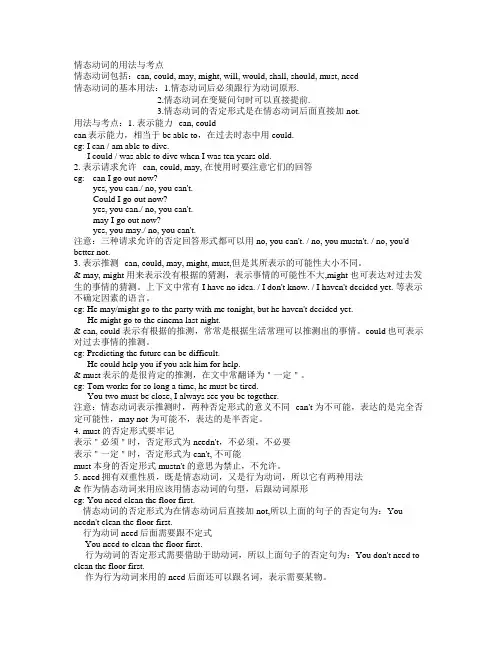
情态动词的用法与考点情态动词包括:can, could, may, might, will, would, shall, should, must, need情态动词的基本用法:1.情态动词后必须跟行为动词原形.2.情态动词在变疑问句时可以直接提前.3.情态动词的否定形式是在情态动词后面直接加not.用法与考点:1. 表示能力--can, couldcan表示能力,相当于be able to,在过去时态中用could.eg: I can / am able to dive.I could / was able to dive when I was ten years old.2. 表示请求允许--can, could, may, 在使用时要注意它们的回答eg: --can I go out now?--yes, you can./ no, you can't.--Could I go out now?--yes, you can./ no, you can't.--may I go out now?--yes, you may./ no, you can't.注意:三种请求允许的否定回答形式都可以用no, you can't. / no, you mustn't. / no, you'd better not.3. 表示推测--can, could, may, might, must,但是其所表示的可能性大小不同。
& may, might 用来表示没有根据的猜测,表示事情的可能性不大,might 也可表达对过去发生的事情的猜测。
上下文中常有I have no idea. / I don't know. / I haven't decided yet. 等表示不确定因素的语言。
eg: He may/might go to the party with me tonight, but he haven't decided yet.He might go to the cinema last night.& can, could 表示有根据的推测,常常是根据生活常理可以推测出的事情。
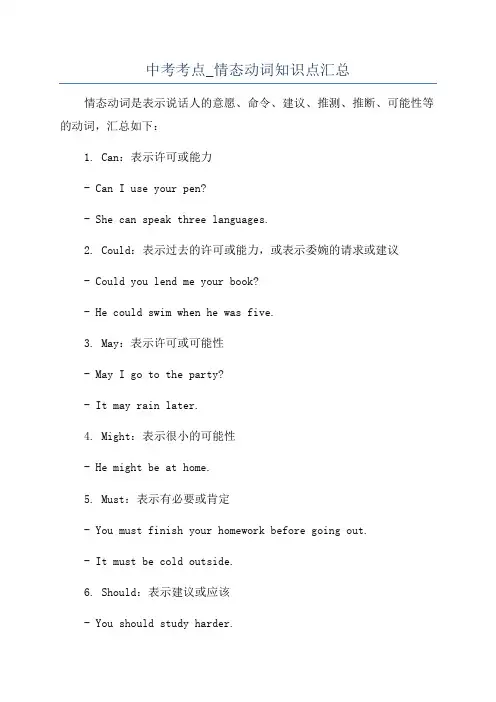
中考考点_情态动词知识点汇总情态动词是表示说话人的意愿、命令、建议、推测、推断、可能性等的动词,汇总如下:1. Can:表示许可或能力- Can I use your pen?- She can speak three languages.2. Could:表示过去的许可或能力,或表示委婉的请求或建议- Could you lend me your book?- He could swim when he was five.3. May:表示许可或可能性- May I go to the party?- It may rain later.4. Might:表示很小的可能性- He might be at home.5. Must:表示有必要或肯定- You must finish your homework before going out.- It must be cold outside.6. Should:表示建议或应该- You should study harder.7. Shall:表示征求意见或提出建议,或用于第一人称的疑问句中- Shall we go to the movies tonight?- What shall I do with this problem?8. Will:表示意愿、意愿、习惯或将来的行动- I will help you with your homework.- She will be here in a few minutes.9. Would:表示过去的意愿或习惯,或表示委婉的请求、邀请或建议- Would you like some tea?- He would always go for a walk after dinner.10. Ought to:表示应该,常用于表达责任或义务- You ought to apologize for what you did.这些是常见的情态动词,掌握它们的用法可以帮助你更准确地表达自己的意图和观点。
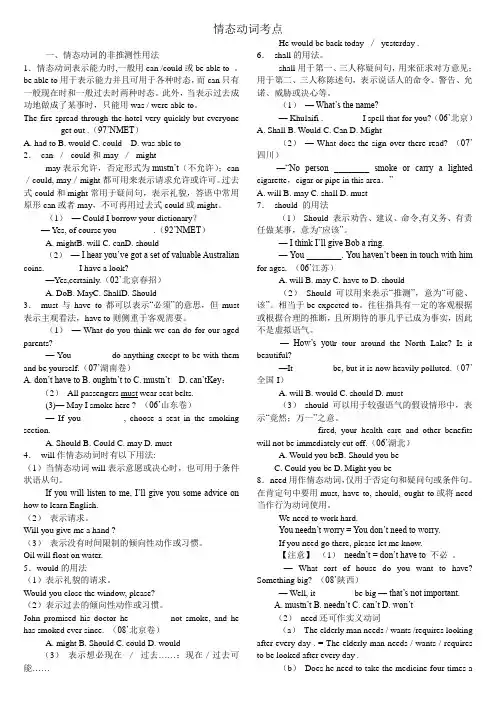
情态动词考点一、情态动词的非推测性用法1.情态动词表示能力时,一般用can /could或be able to 。
be able to用于表示能力并且可用于各种时态,而can只有一般现在时和一般过去时两种时态。
此外,当表示过去成功地做成了某事时,只能用was / were able to。
The fire spread through the hotel very quickly but everyone ________ get out .(97’NMET)A. had toB. wouldC. couldD. was able to2.can /could和may /mightmay表示允许,否定形式为mustn’t(不允许);can /could, may/might都可用来表示请求允许或许可。
过去式could和might常用于疑问句,表示礼貌,答语中常用原形can或者may,不可再用过去式could或might。
(1)— Could I borrow your dictionary?— Yes, of course you________ .(92’NMET)A. mightB. willC. canD. should(2)—I hear you’ve got a set of valuable Australian coins. _______ I have a look?—Yes,certainly.(02’北京春招)A. DoB. MayC. ShallD. Should3.must与have to都可以表示“必须”的意思,但must 表示主观看法,have to则侧重于客观需要。
(1)— What do you think we can do for our aged parents?— You ________ do anything except to be with them and be yourself.(07’湖南卷)A. don’t have toB. oughtn’t toC. mustn’tD. can’tKey:(2)All passengers must wear seat belts.(3)— May I smoke here ? (06’山东卷)—If you ________ , choose a seat in the smoking section.A. ShouldB. CouldC. mayD. must4.will作情态动词时有以下用法:(1)当情态动词will表示意愿或决心时,也可用于条件状语从句。

高考英语情态动词讲解公司内部编号:(GOOD-TMMT-MMUT-UUPTY-UUYY-DTTI-(一)情态动词常考点(一)表能力如:I am starving to death。
I can eat two bowls of rice now。
(现在的能力)我快饿死了,现在我能吃两碗米饭。
If you have a good sleep,you will be able to work out this problem。
(将来的能力)如果你好好睡一觉,你将能够解出这道题。
The fire spread through the hotel very quickly but everyone was able to get out。
(过去有能力做并且成功的做了某事)尽管这场大火迅速蔓延到了整个宾馆,但是每个人都能够逃出去。
I could have worked out the problem,but I didn’t。
(过去有能力做但未做)我本来可以解决这个问题,但没有解决。
(二)表推测(可能性)1.可能性可分为客观的可能性和具体事情实际发生的可能性两种。
所谓客观的(理论的)可能性即并不涉及具体某事是否会发生,此种用法常常可以说明人或事物的特征。
情态动词can可用于肯定句中表示客观的(理论的)可能性,而表示具体事情实际发生的可能性时,can一般不用于肯定句。
如:Accident can happen on such rainy days。
这样的多雨天气有可能会发生事故。
(客观的可能性)Peter may come with us tonight,but he isn’t sure yet。
彼得今晚可能和我们来,但他还没确定。
(实际可能性,不用can)2.表示具体事情实际发生的可能性:这可能是他做的吗?Mr. Bush is on time for everything。
How can it be that he was late for the opening ceremony?(表示疑惑、惊讶)布什先生做每件事都很按时。
情态动词知识梳理情态动词的基本用法:can/could*表具备某种能力叱can表现在能力;could表示过去能力;可用be able to代替;was/were able to表示成功做了某事。
*表请求和允许叱请求用could语气委婉,答语不用couldo*表猜测的•可能性"吐can用于否定和疑问句(could不限);can(be)表示有时候会(常与sometimes,at times 连用)may/might*表请求和允许计请求用might语气更委婉:,允许时用may,表示•可以11(表示允许时不用might)。
六表猜测性,可能性。
"也许"叱此意常用于肯定句(might可能最小)。
六表祝愿吐固定句型为"May+主语+d。
":May you succeed!must*表“必须"wmust多表主观、现在、将来义务;have to多表客观、过去义务;mustrYt表噤止”;否定用needn't/don't have to。
介表推测。
肯定是、准是.吐只用于肯定句。
will/would六表意愿,决心等w would此时为will过去式,无意义差别。
六表经常性,习惯性,倾向性。
叱would表过去反复的动作/某种倾向。
(相对于used to,would do无"现已没有此习惯”之义。
)*表功能.性质叱叙述真理,如:The tree will live without water for3months.女表猜测11想必,大概•(只是时态区别)吐表对目前事物的预料。
如:That will be the postman ringing(would表示过去/现在;will 表示现在/将来)六表“请求/要求-(Will yoiP)用于疑问句,常与you连用。
如:Will you give me a piece of paper9shall(否:shan't)六表征求意见•…好不好.*用在第一、三人称°如:Shall the reporters wait outside or what9六表允诺、威胁、警告、命令或根据规定有义务做吐用于第二、第三人称。
情态动词的主要用法及考点高考重点考查:1、情态动词表示推测(即可能性)2、情态动词+ 完成式(have done)1. can, could(1) 表示能力:“能够,可以”1) could为过去式。
2) could与was/were able to区别:在肯定句中表示过去做成了某事时,只用was/were able to。
3) can/could不能与be able to连用。
(2) 表示可能性:“可能”1) can一般用于疑问和否定句中。
但是,当表示理论上存在的可能性时,也可以用于肯定句中,意为“有时会,有可能”。
2) could不是过去式,用于疑问或否定句。
3) can’t/couldn’t意为“不可能”;may/might not意为“可能不,也许不”(3)表示许可:“可以,能”疑问句中,can/could适用于各人称。
回答时,不可用could。
同时,may/might只用于第一人称I。
(4)表示建议:“可以,不妨”,一般见于肯定句,could不是过去式只是更加客气、委婉。
eg. You can/could watch TV if you feel bored alone at home.2. may, might(1) 表示许可:“可以”(2) 表示可能性:“也许,可能”1) might不是过去式。
2) 只用于肯定和否定句。
(3) 表示祝愿时,只能用may。
(4) may/might as well + 动词原形:“不妨,倒不如”may/might well + 动词原形:“很可能”3. should, ought to(1)表示劝诫或义务责任:“应该”。
(2)表示可能性:指依照常理、常规或习惯进行的推测,意为“理应,想必”。
(3) 以下三种情况只能用should:1)表示“万一”,常见于条件句。
2)表示惊讶或不解,意为“竟然,居然”。
3)在主句有表示“建议,命令,要求”等词的相应名词性从句的谓语中,此时should可以省略。
考点归纳(三)情态动词归纳:1)can / could:表示“能力” (过去时could)表示许可、请求,“可以”(用could语气更委婉)表示推测(否,疑),“可能”could也可表推测(肯,否,疑)表示感情(惊异/不耐烦)“究竟,到底”(主要用于否定句,疑问句和感叹句中。
)How can you be so foolish?could与was/ were able to的区别:could 只表有能力,was/were able to 意含”过去某时经过努力设法做成了某事”, 还可以表示结果He could cure the old man’s illness. (能治好)He was able to cure the old man’s illness. (治好了)2)may / might:表示允许、许可,(用might更委婉)表示推测(肯,否),“或许”、“可能”。
表示祝愿,倒装。
may [might] as well…意为“不妨”、“还是…为好”等,用might 比用may 语气更委婉。
I’m ready,so I might as well go now.我已准备好,因此不妨现在就走。
3)must / have to:表示“必须”表示推测“一定”、“必定”,只用在肯定句中, 其否定形式为can’t,表示“不可能”表示说话人不耐烦的态度,“干嘛偏要”在回答有“must” 的询问时,否定式常用need not (needn’t) / don’t have to表示“不必”, 而不用must not, 因为must not 表示“禁止”“不可以”must 和have to 的区别: must 表示说话人的主观看法, have to “不得不, 必须”,表示客观需要、客观条件只能如此。
have to 比must 有更多形式。
don’t have to表示“不必要”,相当于”needn’t”。